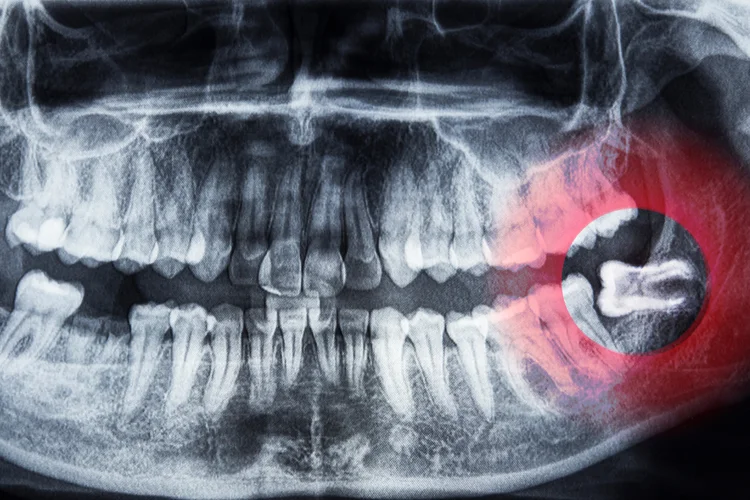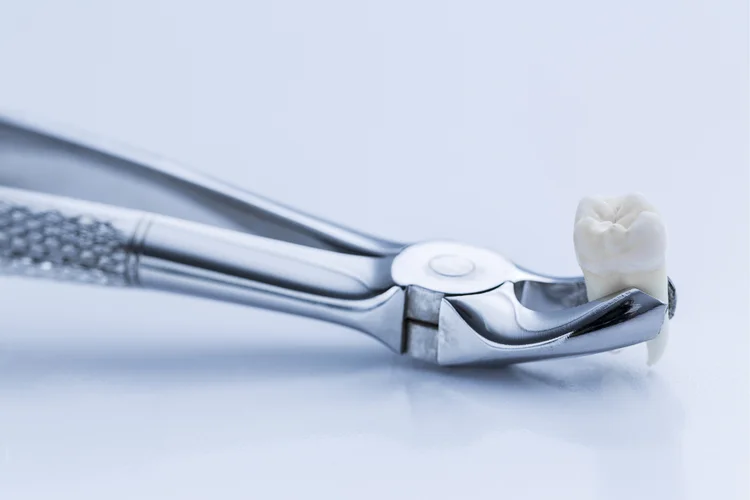Wisdom
teeth can affect your oral health depending on how they grow
and position themselves in the mouth. Whether they erupt
normally or become impacted can influence your risk of pain, infection, or
damage to nearby teeth, and in many cases, may require monitoring or
surgical removal.
The main difference between an impacted tooth and an erupted tooth is
whether the tooth has fully come through the gum and is in the right
position to function like a normal tooth. While both types may
lead to complications, impacted teeth are more frequently associated with
infections, jaw discomfort, and long-term oral health concerns.

| Key Differences | Erupted Wisdom Teeth | Impacted Wisdom Teeth |
|---|---|---|
| Visibility | Fully visible in the mouth | Partially or fully trapped beneath the gum or jawbone |
| Risk of Complications | Low | Higher |
| Common Issues | Decay, gum disease | Pain, infection, cysts, bone loss, or root resorption |
| Likelihood of Removal | Case-dependent | Often required |
| Complexity of Removal | Usually straightforward, similar to routine tooth extraction | More complex, often involves surgical removal |
What Is an Erupted Wisdom Tooth?
An erupted wisdom tooth is one that has fully broken through
the gum and is visible in the mouth. If it grows straight and aligns properly with
the other teeth, it may function like a normal molar.
However, even when fully erupted, wisdom teeth can still lead to problems. Their
position at the back of the mouth makes them harder to reach with a toothbrush or
floss, which can make cleaning more difficult.
What Is an Impacted Wisdom Tooth?
An impacted wisdom tooth is one that
does not fully emerge into the mouth. This can happen when there is not
enough space in the jaw, when the tooth is blocked by neighbouring teeth, or
when it grows at an angle that prevents proper eruption.
As a result, part or all of the tooth remains trapped beneath the gum or
within the jawbone.
There are three main types of impaction:
- Soft tissue impaction – The tooth is covered by gum tissue.
- Partial bony impaction – The tooth is partly covered by bone.
- Complete bony impaction – The tooth is completely enclosed within the jawbone.

What Symptoms Indicate an Impacted Wisdom Tooth?
Symptoms of an impacted wisdom tooth can range from mild discomfort to more serious signs of infection or structural complications. You may notice:
- Pain or tenderness near the back of your jaw.
- Swelling or redness of the surrounding gums.
- Limited ability to open your mouth (trismus).
- Swollen lymph nodes or facial swelling.
- Unpleasant taste or bad breath.
- Fever or general unwellness in cases of infection.
In some cases, impacted wisdom teeth may not cause noticeable symptoms but can still lead to problems over time.
What Complications Can Arise From Impacted or Erupted Wisdom Teeth?
Wisdom teeth, whether erupted or impacted, can lead to a range of oral
health problems, particularly when they are hard to clean or poorly
positioned.
Both erupted and impacted wisdom teeth may contribute to:
- Tooth decay, due to difficulty reaching the area with a toothbrush or floss.
- Gum inflammation, including pericoronitis, especially if a gum flap traps food and bacteria.
- Persistent bad breath and unpleasant taste, from trapped debris and bacterial buildup.
- Pressure or damage to neighbouring molars, potentially affecting alignment or causing decay.
- Periodontal problems, such as gum irritation or bone loss near the adjacent tooth.

Impacted wisdom teeth, which remain partially or fully trapped under the gum or jawbone, are also associated with:
- Chronic jaw pain or swelling, often resulting from ongoing inflammation, pressure within the bone, or repeated episodes of infection around the impacted tooth.
- Cysts or tumours, which can form around the impacted tooth and gradually damage the surrounding bone and tissue structures, even when no symptoms are present.
WhatsApp Us Now
How Are Wisdom Teeth Diagnosed?
Assessing and diagnosing impacted or disrupted wisdom teeth typically involves a combination of clinical examination and imaging. This may include:
- Visual assessment to observe how the tooth is erupting and to examine the condition of the surrounding gums.
- Dental x-rays to determine the position of the tooth, the structure of the jawbone, and check its relationship to neighbouring teeth, especially if the tooth is not fully visible.
- Additional tests, such as pulp vitality testing, may be used to check the health of nearby teeth if an impacted tooth is suspected to be affecting them.
Treatment for Impacted or Erupted Wisdom Teeth
Treatment options for wisdom teeth vary depending on whether the teeth are
erupted or impacted, and whether they are causing problems or likely to do
so in the future.
Erupted wisdom teeth may not require removal if they are
healthy, properly positioned, and easy to clean. However, removal might be
recommended if they:
- Cause discomfort or inflammation in the surrounding gums.
- Are difficult to clean, increasing the risk of decay or gum disease.
- Trap food and lead to persistent bad breath.
- Affect the alignment of neighbouring teeth, disrupt your bite, cause jaw discomfort, or interfere with dental restorations.
In most cases, removing erupted wisdom teeth is a relatively straightforward extraction and can be done under local anaesthesia, similar to a routine tooth extraction.

Impacted wisdom teeth are more likely to need removal, especially if they are trapped beneath the gum or bone. Your dentist may recommend removal of the teeth:
- Cause pain, swelling, or signs of infection.
- Are pressing against neighbouring teeth, potentially causing damage.
- Are associated with cysts or early signs of bone loss.
- Are likely to lead to future problems, even if no symptoms are currently present.
Removal of impacted teeth is generally more complex and may require minor oral
surgery.
Read our guide on the
differences between routine extractions and surgical removal for more
information.
When to See a Dentist About Wisdom Teeth?
You should see a dentist if you experience persistent pain, swelling, difficulty
opening your mouth, or other symptoms that may be related to your wisdom teeth.
Even if no symptoms are present, regular dental check-ups are important for
monitoring the development and position of your wisdom teeth. Early detection allows
your dentist to identify potential problems before they become more serious.
Book a Wisdom Tooth Consultation With Our Friendly Dentists Today!
Book Wisdom Tooth Appointment
Book NowEnquire More Through Email
Email Us NowEnquire More Through WhatsApp
WhatsApp Us NowWhy Choose True Dental Studio?
Friendly Dentist and Team
Our team treats each and every patient to the best of our ability. This is the reason why entire families have continued their dental care with True Dental Studio for many years, from all over Singapore.
Minimal Discomfort
At True Dental, it is our commitment to ensure our patients are kept as comfortable as possible. We aim to minimize discomfort, if any, for our patients.
Affordable Treatments
We believe in pricing quality treatments at a competitive rate. We are transparent and upfront with our treatment costs.
Our Smile Scorecard
Frequently Asked Questions
An impacted wisdom tooth is one that does not fully erupt into the mouth and may be trapped under the gum or jawbone. Common signs include jaw pain, swelling, difficulty opening the mouth, or bad breath. However, some impacted teeth cause no symptoms and are only detected through dental X-rays. If you suspect an impacted wisdom tooth or are experiencing symptoms, it is best to consult a dentist for proper evaluation to determine if it requires further treatment.
Impacted wisdom teeth often require removal if they cause symptoms or pose a risk of future complications. These may include pain, infection, root resorption, or cyst formation. In some cases, removal may be recommended even without symptoms if the tooth is poorly positioned. It is best to consult a dentist who can determine the most appropriate approach based on your oral health.
The main difference is that regular (erupted) wisdom teeth have fully emerged through the gum and may function like normal molars if properly positioned, while impacted wisdom teeth remain partially or fully trapped beneath the gum or bone. Impacted teeth are more likely to cause complications and often require more complex treatment, including surgical removal when clinically indicated.
An impacted wisdom tooth may remain in place if it is not causing symptoms, but it requires regular monitoring. Over time, it can lead to complications such as decay, gum inflammation, cysts, or damage to adjacent teeth. Removal is often recommended even in the absence of symptoms. It is best to consult a dentist to determine the most appropriate treatment approach for your specific case.
Ignoring an impacted wisdom tooth can lead to complications such as infection, cyst formation, or damage to nearby teeth. Even if symptoms are not present, the tooth may still cause gradual changes like bone loss or root resorption. It is best to consult a dentist or oral surgeon who can help determine if monitoring or removal is appropriate based on your specific condition and long-term oral health risks.
Wisdom teeth typically begin to grow when the third molars start erupting during late adolescence or early adulthood, usually between ages 17 and 25. Their eruption is guided by biological growth patterns and may be influenced by jaw size, genetics, or available space. Some may remain impacted if they lack room to emerge properly, requiring monitoring or treatment depending on the circumstances.
Complete bony impactions are generally considered the most difficult type of wisdom teeth to remove. These teeth are fully enclosed in the jawbone, often requiring surgical access and sectioning. Removal complexity also depends on factors such as tooth angle, proximity to nerves, and bone density.
Wisdom teeth usually complete their development and root formation by the mid-to-late twenties, although eruption may stop earlier if impaction occurs. Once growth stops, their position remains stable, but complications can still develop later in life. Regular dental reviews and imaging can help monitor changes over time and determine if intervention is needed.
The urgency of an impacted wisdom tooth depends on whether it is causing or likely to cause complications. Pain, swelling, or infection may require timely treatment, while asymptomatic teeth can often be monitored. If your wisdom tooth is causing discomfort or interfering with daily activities, it is advisable to consult a dentist for a proper assessment to determine the most appropriate course of action.
Healing after the removal of an impacted wisdom tooth usually takes several weeks, with soft tissue closure occurring within 2 to 4 weeks. However, full bone remodelling beneath the gum may take up to 6 months. It is best to discuss with your dentist or oral surgeon to understand the expected recovery timeline based on the complexity of your extraction.
Wisdom teeth are not routinely removed before they erupt unless there is a clear risk of complications, such as crowding or abnormal angulation. In some cases, early removal may be advised to prevent future issues. It is best to consult your dentist to assess your wisdom teeth and determine whether monitoring or pre-emptive removal is more appropriate.
To clean partially erupted wisdom teeth, use a soft-bristled toothbrush to gently clean around the tooth and gum flap. Antimicrobial mouthwashes like chlorhexidine may help reduce bacteria, while interdental brushes or oral irrigators can assist in removing trapped debris. Always follow your dentist or hygienist’s instructions for tailored oral hygiene advice based on your individual condition.
Wisdom tooth eruption pain typically lasts a few days to a couple of weeks, depending on the tooth's position and whether it erupts fully. Discomfort may worsen if the tooth becomes partially trapped or inflamed. If symptoms persist or worsen, it is best to consult a dentist to help identify whether treatment is needed for complications such as infection or impaction.
Erupted wisdom teeth are generally easier to extract because they are fully visible and not trapped beneath gum or bone. The procedure is usually similar to a routine tooth extraction and is often performed under local anaesthesia. However, factors such as the tooth’s position or root shape can still affect complexity. A consultation and examination by a dentist can determine the expected difficulty of your extraction.
Partially erupted wisdom teeth are generally more complex to remove than fully erupted teeth but may be less challenging than completely impacted ones. The degree of gum or bone coverage and the tooth’s angulation influence surgical difficulty. Consulting a dentist can help provide a clearer understanding of how complex your wisdom tooth removal may be.
